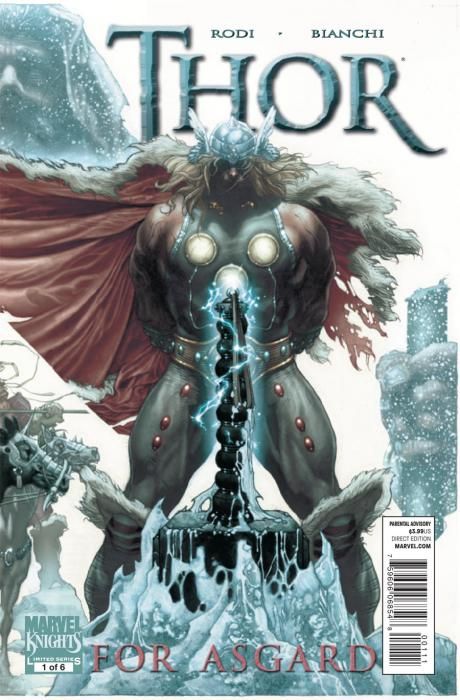Simone Bianchi was born to draw a Thor comic; When he was announced as the artist on "Thor: For Asgard", it seemed like the perfect match of character and artist. His work on "Seven Soldiers: Shining Knight" showed his ability to take warrior cultures and portray them as strong and violent, while also beautiful and intricate in their armor and weaponry. He takes simple things like swords and adds small touches to give them an alien and majestic feeling. In "Thor: For Asgard" #1, he uses the base level of the warrior culture and fantasy look of the Asgardians, but adds in otherworldly and rich elements like jewels or Simone Peruzzi's additions of what looks like a glow coming from some of the gods to indicate that these are not mere mortals, they are the Asgardian gods. They are warriors and gods, and their kingdom is falling to ruins.
Robert Rodi's story begins in a fairly typical fashion with Thor and his fellow Asgardians fighting against a group of rebellious Frost Giants that attempt to use the women and children of their village as a means to make the gods stand down. While that doesn't work, we learn that this isn't the only village that is rebelling against the gods' rule and that the entire kingdom has been in a state of winter for over two years following the death of Balder. Ragnarök appears to be coming and, with Odin gone and food supplies running low, Thor doesn't know how to solve the problem except for acting the warrior.
The concept of watching Asgard slowly crumble and die is an interesting one that Rodi runs with by creating a status quo where no one seems to know what to do. Everyone knows what's coming and that they're in danger of dying, but there is no solution at hand except to stay the course and have faith in Odin. At times, Rodi's dialogue is over-the-top in trying to capture the tone and bombast of the Asgardians, like Thor's declaration of battle on the opening page or the argument between Tyr and Sif.
In part, the overwriting seems designed to make up for Bianchi's main flaw: his panel to panel storytelling and clarity. In some spots, it reads like Rodi added in dialogue to make clear something that the images should have communicated. A scene where Thor goes to the Throne Room and broods loses its impact, because of the overbearing narration and the odd flow of Bianchi's page. But, at other times, like the fantastic final sequence, Binachi's art carries the scene. There's an ebb and flow throughout the issue that does get better as the issue progresses. Despite some storytelling problems, Bianchi's pages are gorgeous and lush. As he told CBR's Dave Richards back in July, "I'm pretty much creating a brand new world from scratch; buildings, interiors, armor, weapons, all the little details. So it was a good chance for me to show off what I can handle the best," and he pulls it off.
There's a strong sense of design to his pages and the world they contain. The space in the room that houses Mjolnir and the hallway Thor walks through have a very medieval feel to them, while also suggesting the grandeur of Asgard. His design for the buildings' exteriors mix a sort of futuristic design with ancient towering spires.
Bianchi's art lives up to expectations and is a great match for the characters and world, while Robert Rodi sets up an intriguing story. There's a strong sense of how wrong things have gone in the world, culminating with the scene involving Thor and his hammer that is somewhat shocking. If you like your Thor with a healthy dose of fantasy influence, "For Asgard" is your book.

